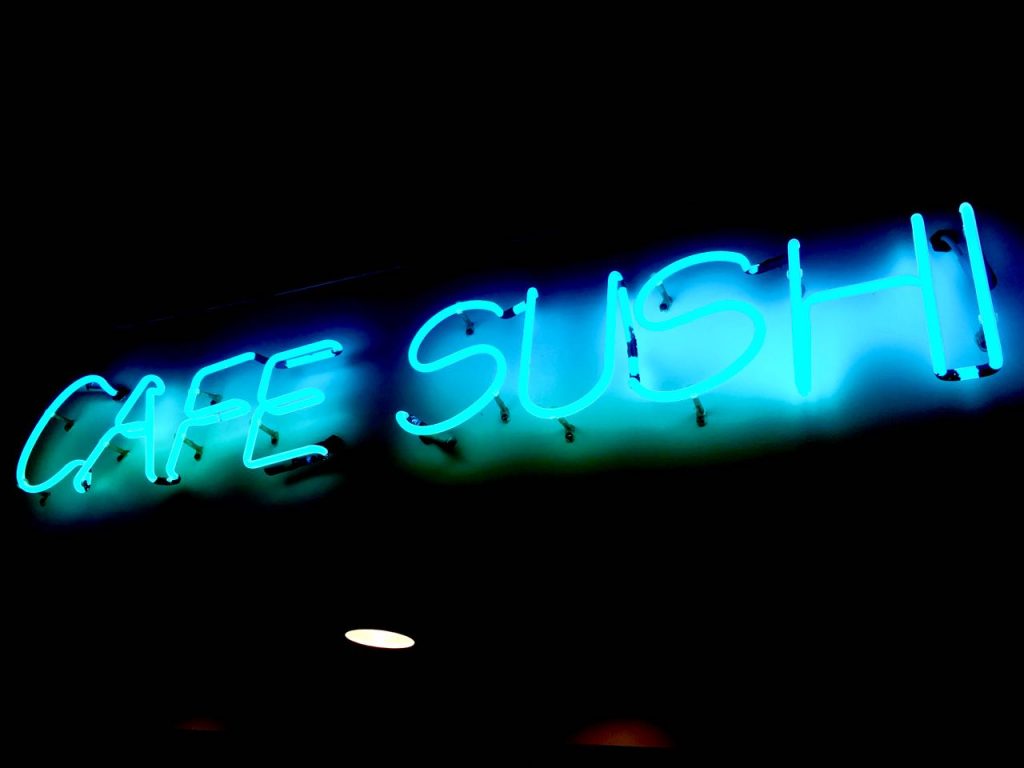

The Vitals:
the spot: Cafe Sushi 1105 Massachusetts ave Cambridge MA 02138
the eats: Omakase (chef’s tasting menu of sushi, cooked items)
the bucks: $110
the full nelson: top shelf sushi meets no frills environment and an overall bargain of an omakase experience
I recently found myself in Boston searching for Cheap Eats (#staytuned) when a local chef put me in the know about Cafe Sushi, a full on Bang for your Sushi Buck place if you like to take your sushi to Omakase overdrive. For the uninitiated, Omakase is Japanese for “I’ll leave it up to you”; essentially giving the chef carte blanche to design a tasting menu of the very best. The phrase infers respect but it also is saying to the chef – “show me what you got”. If you thought sushi was expensive, well omakase is taking upgrading your Benz to an AMG or at the right places, a full on Maybach. In the case of Cafe Sushi, I would say you are upgrading to a flagship Lexus – a relative bargain amongst the world of high end dining but far from chump change. And what is the MSRP you ask? $110 per person. Yes, this meal breaks triple digits before a single drop of sake or beer. Is it worth it? For the true sushiphile, read on and let the hunger games begin!!
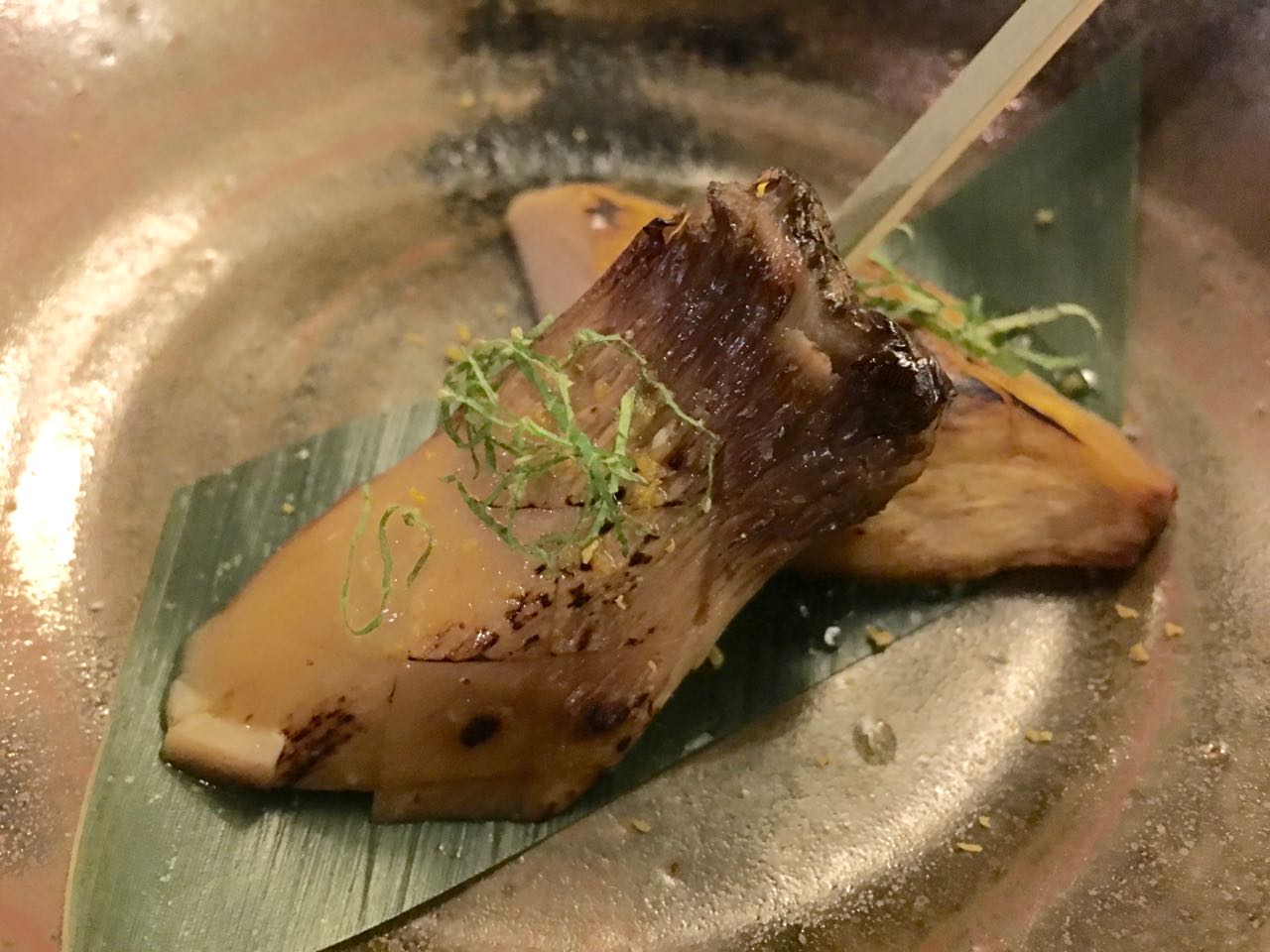
First Course: Roasted King Oyster Mushroom with sea salt, olive oil, shiso and lemon zest
Ironic that a $100+ meal of sushi commences with a cooked item? Well keep in mind that we begin with a subtle dose of umami. The beauty of tasting menus is that you experience tastes versus a plate of food whose net goal is to have you feeling full in about 15-20 minutes after the initial wow of flavor to your palate. Also oyster mushrooms are just fantastic on their own, these had meaty texture though the flavor is more subtle than say a Portabello or Crimini.
Second Course: Japanese Barracuda on cedar plank, house aged soy sauce and myoga(Japanese ginger bulb)
Regrettably in my growing sushi euphoria, I consumed this course before firing off the pic. Still my obligation to include it is less for proof course quantity than a reflection of a challenge of tastes. Barracuda is a meaty fish with a heavy oil content, pronounced in flavor like bluefish. I came across a blog post where the author broke down a whole fish into sashimi. His notes mention that aside from a strong “fishiness” the barracuda needed umami. The barracuda at Cafe Sushi not only came dressed in a house soy sauce(this whole meal I never reached for a bottle nor for a mound of wasabi) but also on top of a cedar plank. There was some cooking applied, but far from a cooked through piece of fish either. Certainly rich, with a touch of funk, this is not entry level sushi here folks. This course was a sign that challenges and new sushi flavor experiences were to come. Any notion of seared albacore followed by a succession of spicy fill in the blank rolls, quickly faded from my rearview.
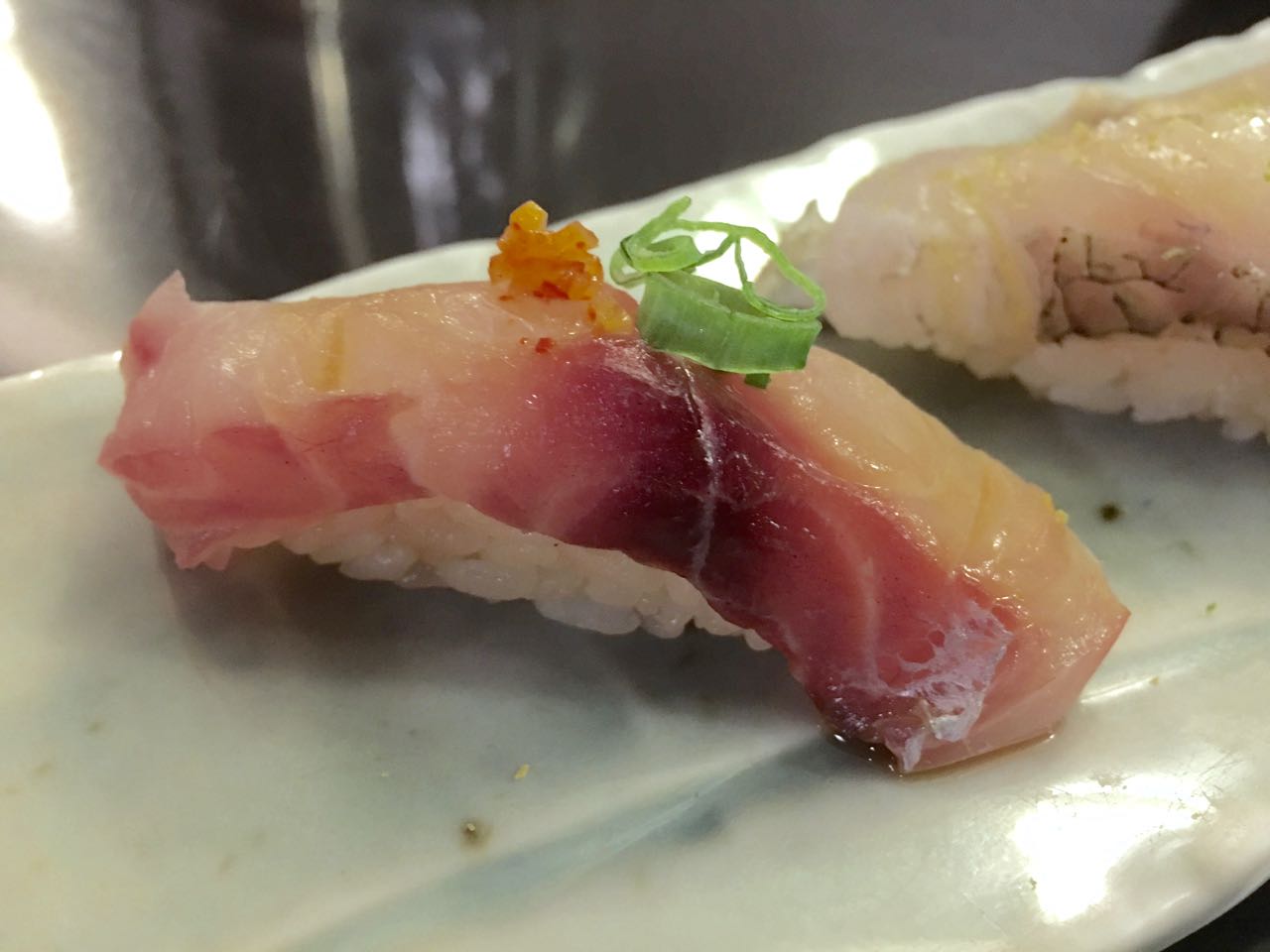
Third Course: “Grunt” a snapper woth ponzu and preserved lemon
Snapper certainly falls into the subtle category of sushi. At lesser places it is a waste of money and valuable stomach real estate. At better places it is at best, subtle and a welcome break from the runway hits like toro(tuna belly) or sake(salmon). But you are not here for a mix tape of top 40 hits at Cafe Sushi. You are here for an experience you cannot predict, a chorus that is not so digestible. Again I must mention that this piece of nigiri came fully dressed in ponzu, that citrus laced soy sauce and complimented with preserved lemon. A refreshing move from the meat barracuda. The point of this piece of sushi was that we begin to move through a wave of flavors, moving back and forth from bright and clean flavors to rich and savory. And I could simply not predict what would come next.

Third Course: Sea Bream with olive oil and West Virginia salt with a zest of lime
Also part of the third course was this piece of Sea Bream nigiri. Key moves here are the olive oil and salt, which took my palate over to the Mediterranean vs Japan. Think crudo(Italian sashimi) when you look at this piece of nigiri. Subtle, yes but also proof that not all sushi needs to be dunked in soy sauce and smeared in wasabi.
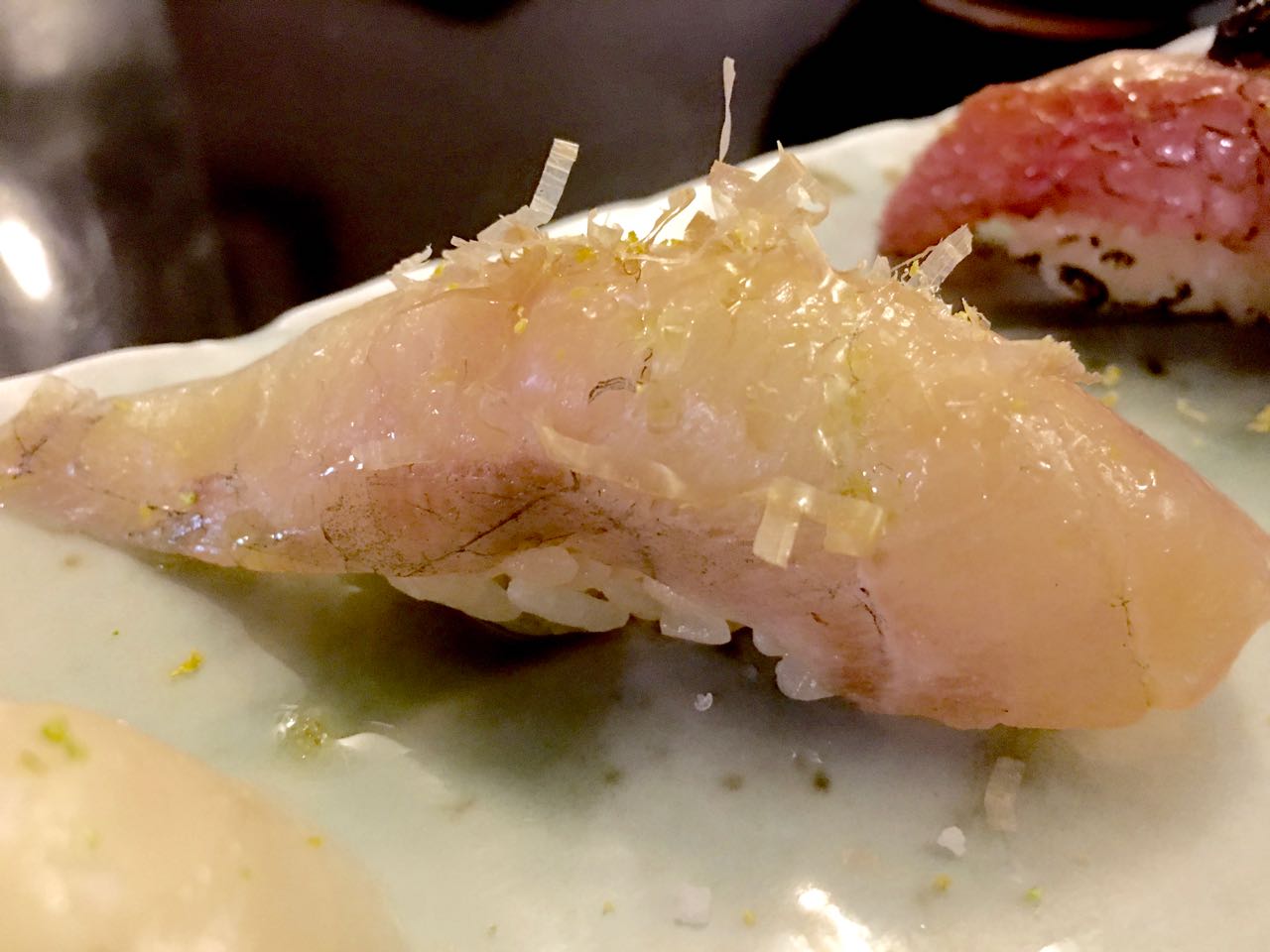
Third Course: Sea Trout cured in Kombu wasabi oil and bonito flakes
While soy and wasabi can seem like monotonous flavors in sushi, one cannot deny the power of the Japanese horseradish when applied to raw fish. And the bonito flakes add a nice touch of umami as well. In the right light it almost looks like gold flakes. And when you think about how much sushi costs, they might as well be.

Third Course: New Zealand Golden Eye Snapper, slightly seared and topped with a shallot marmalade
While typical sushi feasts ebb and flow between fatty and lean cuts of fish, the theme at Cafe Sushi was between subtle and meaty, with this snapper falling into the latter category. The sear of the fish gives the nigiri a heavier finish but the shallot marmalade on top really seals the deals as one of the heartier pieces of nigiri in the evening. Heavy on the umami, the shallot marmalade was reminiscent of the cooked down onions on French Onion soup or the burger at Father’s Office in LA.
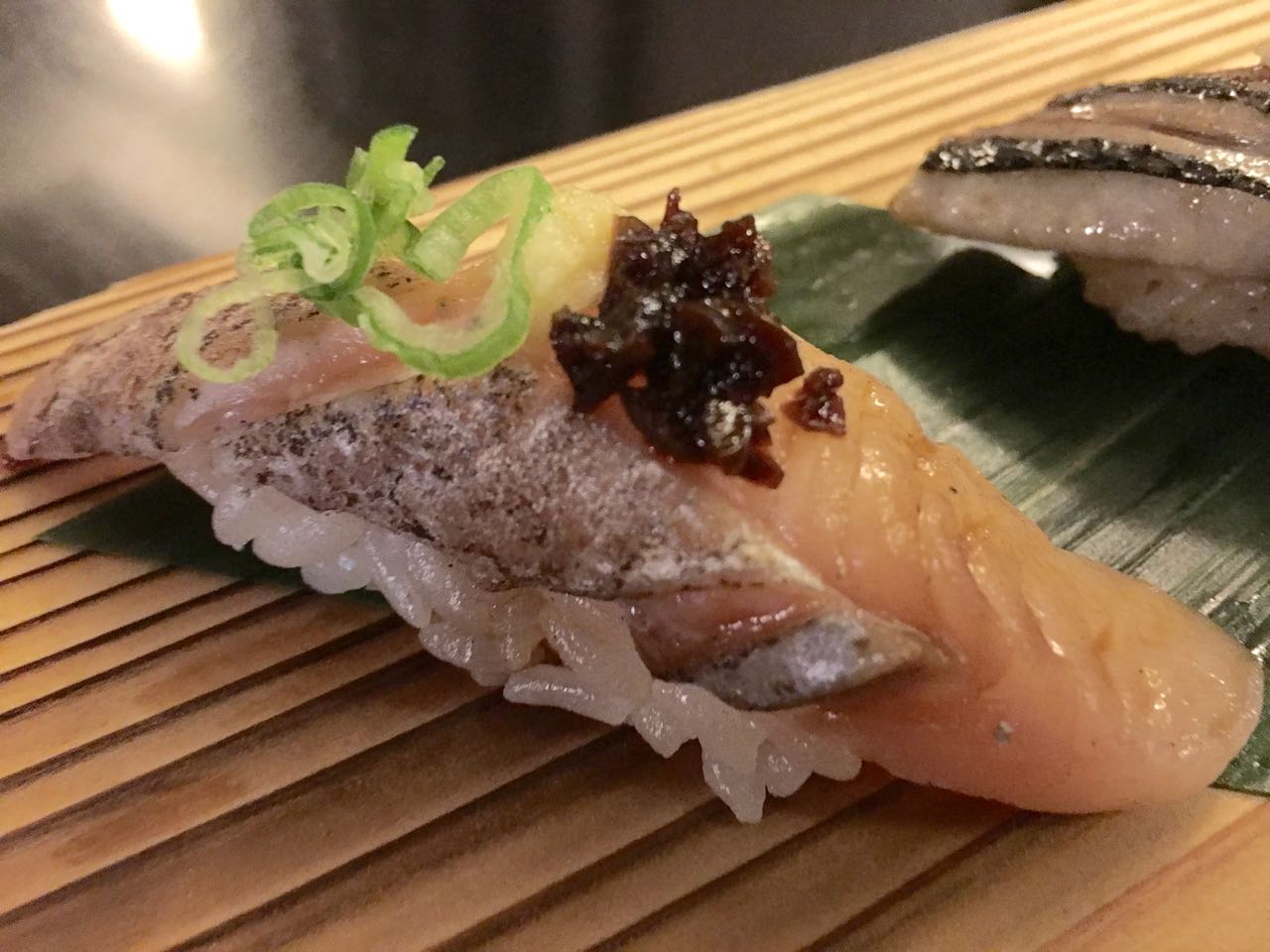
Fourth Course: Virginia Spanish Mackrel topped with ginger, scallion and garlic in tamari
The meaty nigiri continued onto the fourth course with this East Coast Spanish Mackerel. Mackerel is one of my favorites at good sushi places. The predatory fish has a pungent taste that when served fresh and tamed properly, is so rewarding. Ginger and garlic could tame nearly anything and the addition of the tamari only further kept the strong fish flavors at bay.

Fourth Course: Iwashi Japanese Sardine with pickled red onion
If you like Mackerel you will also like Sardine as well. It isn’t often that I find Iwashi(Japanese Sardine) on a sushi menu but it seldom disappoints. The pickled red onion, like the ginger and garlic on the Mackerel also balances the zest of the Sardine. They chose to char the skin though if they had not mentioned, I would have never known.

Fifth Course: Iwana Canadian Arctic Char cured in soy sauce
If there ever was a point during the meal where the sushi felt familiar it would have been here. Arctic char looks and tastes like salmon. If you ever see some at a store, do yourself a favor and buy it to cook at home, with a higher fat content than salmon, I think the stuff is like salmon on steroids. Being cured in soy and being rich piece of fish made this for one fine bite of nigiri. This was a straight up crowd pleaser.
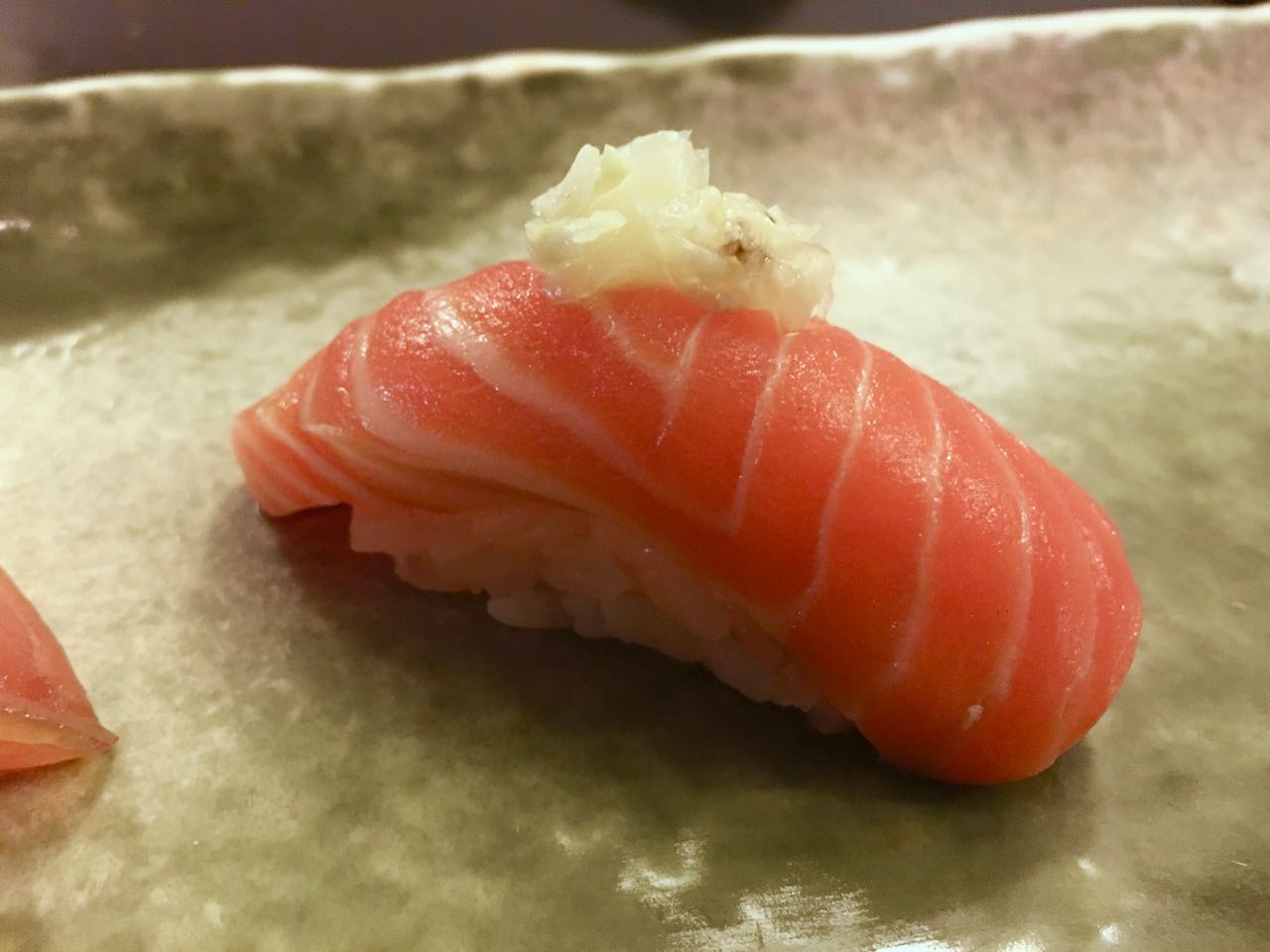
Fifth Course: New Zealand King Salmon topped with salt Napa Cabbage
As stunning as this piece of salmon looks, it just didn’t blow me away. Maybe at this point yours truly was missing some of that familiar soy and wasabi to match the fatty salmon but overall this was a subtle taste for something my eyes read as “fatty salmon sushi time”

Sixth Course: Atlantic Bay Scallops with Armenian cucumber in a light vinegar dressing
I adore scallops and of course, the fresher the better. In the context of sushi, the scallops can’t get fresher, however the delicate flesh of a raw scallop can get lost with sushi rice. I think the move is sashimi and the Armenian cucumber offered a nice contrast of texture. If only all salads could involve scallops – I might frequent salad bars more.
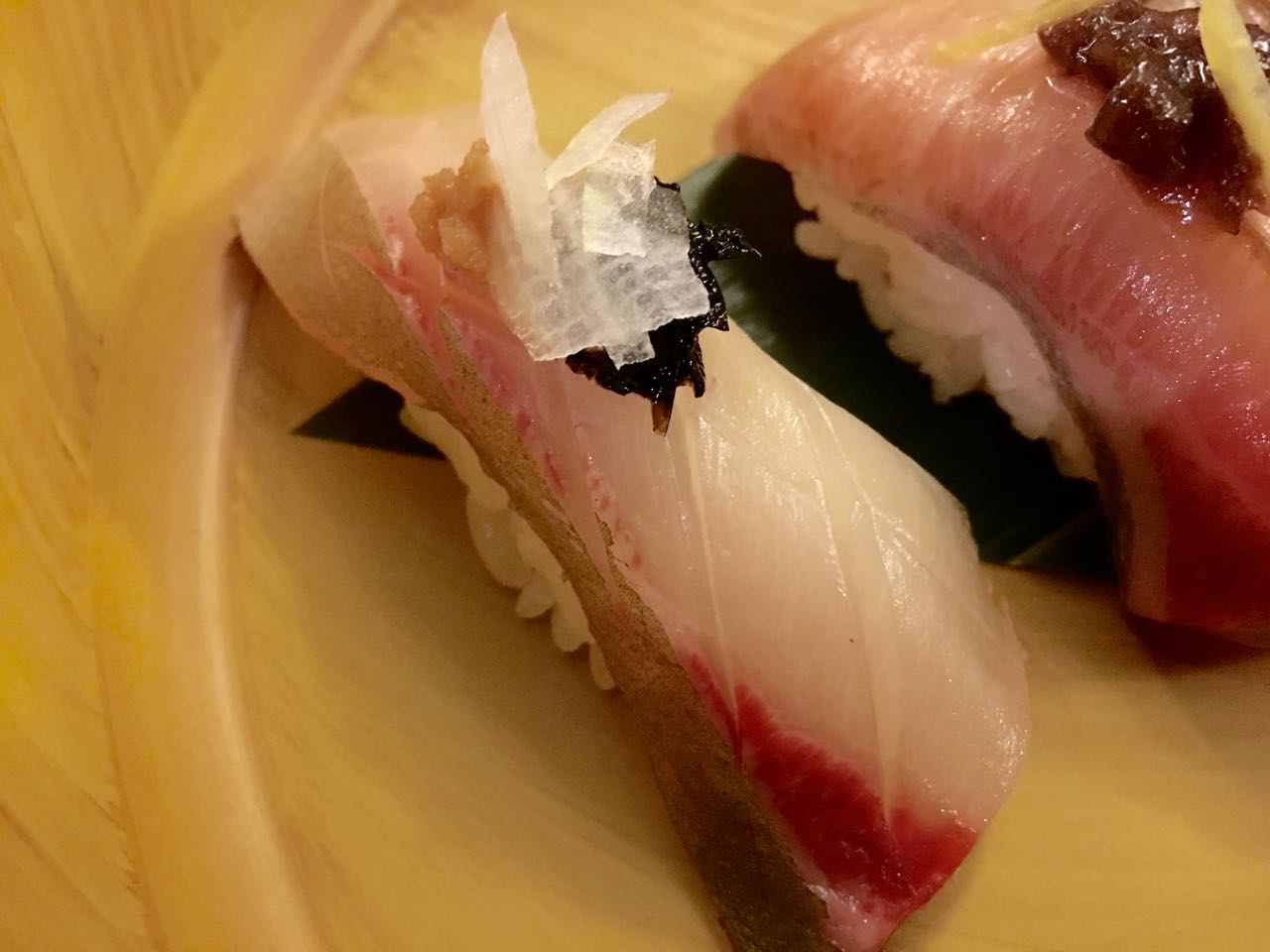
Seventh Course: Shimaji Japanese Striped Jack with braised seaweed, iced onions and lemon miso
Even though this sushi feast strayed from the pedestrian, it finished off with a touch of the familiar and an overall satisfying round of nigiri. Striped Jack is firm and fatty when aged and the dollop of iced onion and lemon miso added that umami that makes this piece of nigiri a true lip smacker.
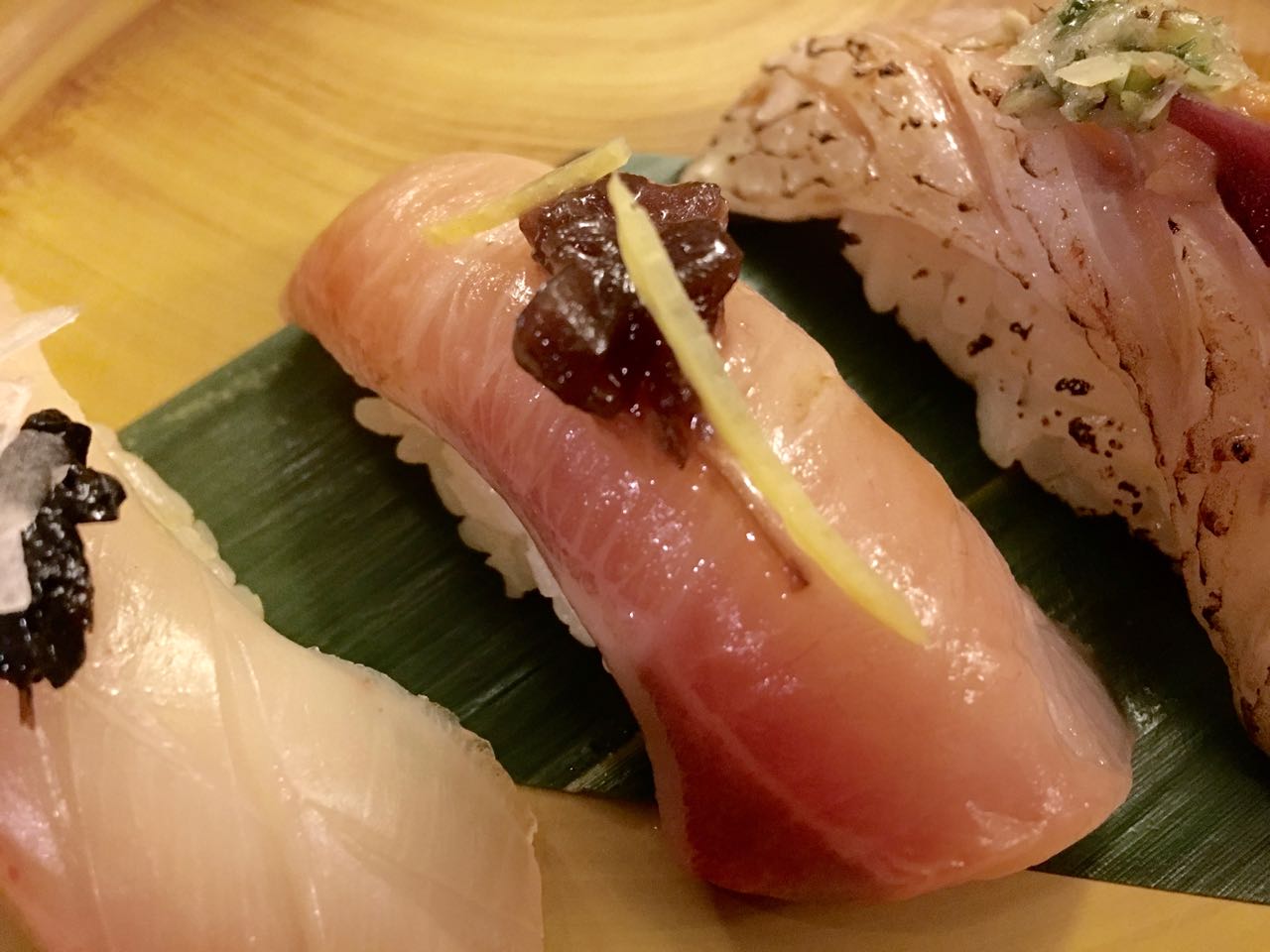
Seventh Course: Kampachi with hickory and a caramelized onion preserved, lemon peel and house soy
Yes, there was soy sauce to be had and Kampachi(also known as Kanpachi and Amberjack) is certainly a popular fish in sushi restaurants across the country. You might know it as yellowtail and it is a go to for expert and novice sushi aficianados alike. You just can’t go wrong here.
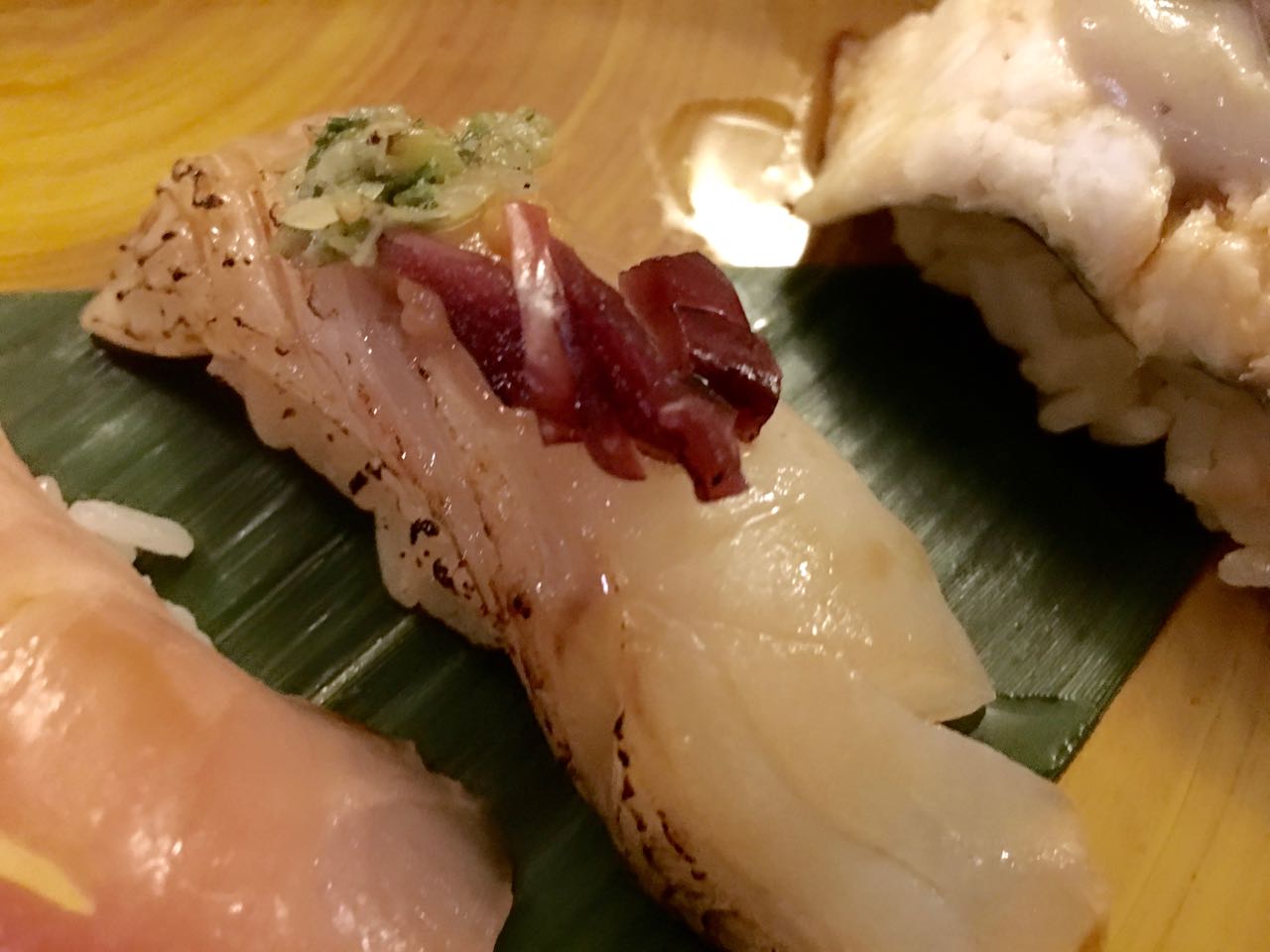
Seventh Course: Japanese Rosy Sea Bass, lightly seared, charred red pickle cabbage, hot miso, charred scallion and sesame oil
Of course one of the priciest pieces of nigiri that night would be my favorite. My first time experiencing Japanese Rosy Sea Bass and certainly not my last(provided I can afford it). I would say the fish was stellar but like every piece of nigiri that night, the accompanying flavors were fascinating, subtle and of course complimentary. This was one of the best examples of seared sushi I have had in a very long time, not surprisingly the fish has a high fat content so a little heat simply allows the flesh to be bathed in its own oils. So so so good.

Seventh Course: Sea Eel prepared in house, steamed, ponzu chestnut puree, beach mushroom
Too often eel is bathed in sugary Unagi sauce, masking its true flavor. Maybe the chestnut ponzu was a play on Cafe Sushi calling New England its home but in my book if you are making your own soy sauce, you can only do wonders with your own ponzu. My first time having a beach mushroom and I can only assume trying land a sea of these on a pizza would shatter my bank account. All in all a fine bite of nigiri.
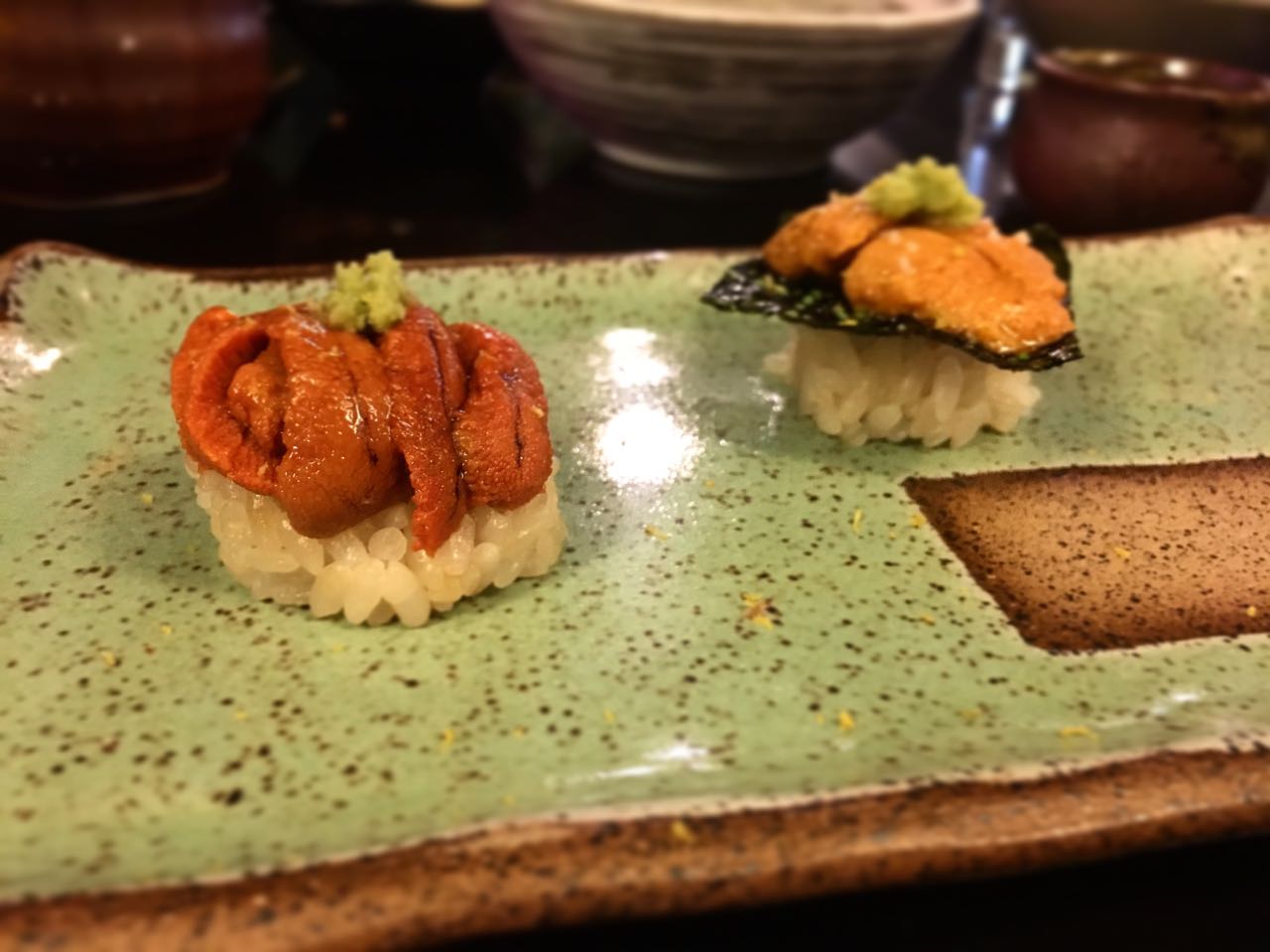
Eighth Course: A duo of Sea Urchin. Uni from Maine with grated wasabi and Uni from Santa Barbara on crispy nori with olive oil and West Virginia salt
Uni is literally dessert for me at a sushi restaurant. The sweet creamy taste of the sea pretty much could qualify as my last meal on earth. Between the two, my fav was the Uni from Maine, after all Maine is a lot closer than Santa Barbara to Boston. Santa Barbara is renowned for their Uni but something about the sweetness of the Uni from Maine simply one me over. Still to have two types of Uni for the end of your Omakase is just good living right there.
Overall favs here were the Uni from Maine, the Japanese Rosy Sea Bass, the Kampachi, the Scallop sashimi, the Arctic Char and the Spanish Mackerel. By far one of the most focused sushi meals when it comes to milder white fish, I have to say it was a welcomed change from the sea of tuna(pardon the pun) you get at most places. Even after calling LA home for 20 years it is amazing to see serious sushi happening on the East Coast besides NYC. My second visit might be more focused on my favs of this night but for your first foray into Cafe Sushi, the $110 Omakase is a great way to experience a lot of what this legit sushi place has to offer. No doubt some Bang for your Omakase Buck.
Leave a Reply